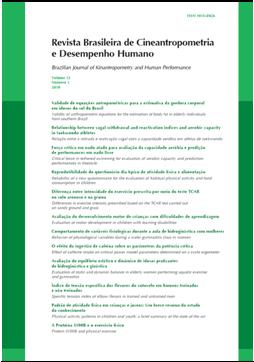Força crítica em nado atado para avaliação da capacidade aeróbia e predição de performances em nado livre
DOI:
https://doi.org/10.1590/1980-0037.2010v12n1p14Resumo
O presente estudo investigou as relações da força crítica (Fcrit) com o limiar de lactato (LLNA) e a intensidade de exercício correspondente ao VO2max (iVO2max) em nado atado (NA) e suas correlações com as performances de 400m (V400) e teste de 30 minutos (VT30) em nado livre (NL). Sete nadadores foram submetidos a teste incremental em NA para determinação do LLNA e da iVO2max. Para determinação da Fcrit, os nadadores realizaram 4 esforços até a exaustão com intensidades (F) correspondente a 87%, 104%, 118% e 134% da iVO2max para obtenção dos tempos limites (tlim). A Fcrit correspondeu ao coeficiente linear da relação entre a F e 1/tlim. Os valores de Fcrit (51,97 ± 4,02 N) foram significativamente diferentes da iVO2max (60,21 ± 8,73 N), mas não do LLNA (45,89 ± 8,73). A Fcrit foi significativamente correlacionada com o iVO2max (0,97), LLNA (0,88), V400 (0,85) e VT30 (0,86). Os resultados sugerem que a Fcrit pode ser utilizada na determinação da capacidade aeróbia, prescrição do treinamento em NA e na predição de performance em NL.Publicado
2010-12-11
Edição
Seção
Artigos Originais
Licença

Direitos Autorais para artigos publicados nesta revista são do autor, com direitos de primeira publicação para a revista. Em virtude da aparecerem nesta revista de acesso público, os artigos são de uso gratuito, com atribuições próprias, em aplicações educacionais e não-comerciais, desde que seja dada a atribuição. Esta obra foi licenciada com uma Licença Creative Commons Atribuição 4.0 Internacional - CC BY


